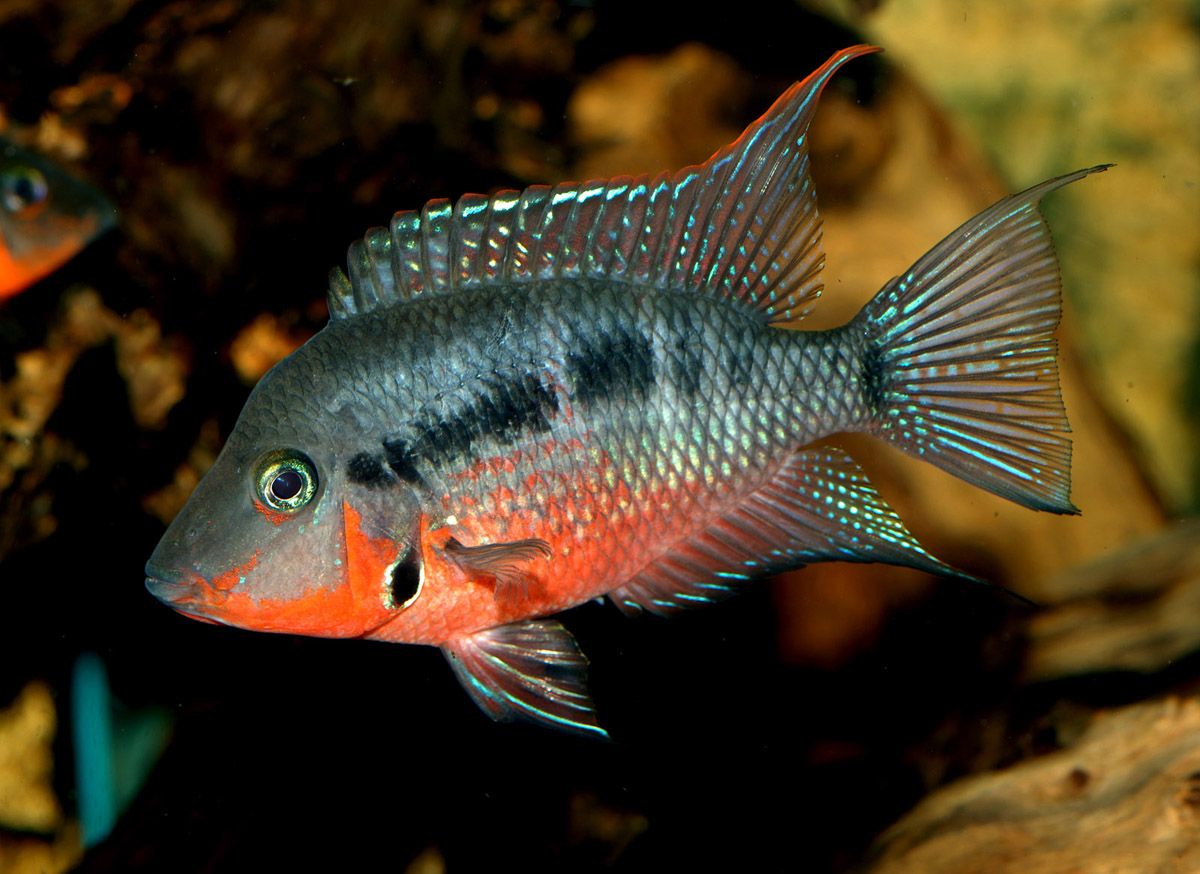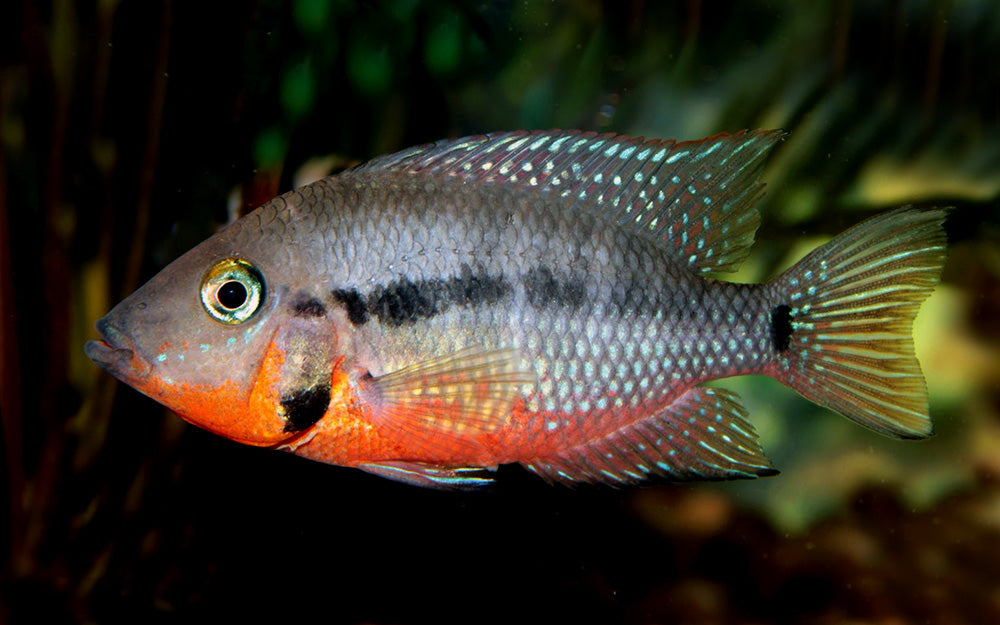1
/
of
2
Firemouth Meeki Cichlid (Thorichthys meeki) - 2" - Live Fish
Firemouth Meeki Cichlid (Thorichthys meeki) - 2" - Live Fish
Regular price
$12.99 USD
Regular price
$0.00 USD
Sale price
$12.99 USD
Unit price
/
per
Shipping calculated at checkout.
0
Total items
$0.00
Taxes, discounts and shipping calculated at checkout.
Product subtotal
Remove all 0 items from your cart?
LOCAL DFW Pickup available
Firemouth cichlids (Thorichthys meeki) are a beautiful species of freshwater fish native to Central America, particularly found in the Yucatan Peninsula, Mexico, Belize, and Guatemala.
Detailed Description
Detailed Description
LOCAL DFW Pickup available
Firemouth cichlids (Thorichthys meeki) are a beautiful species of freshwater fish native to Central America, particularly found in the Yucatan Peninsula, Mexico, Belize, and Guatemala. They are named for the distinctive red coloration around their mouths, which resembles a fiery blaze.
Here are some key points about Firemouth cichlids:
Appearance: Firemouth cichlids typically have a grayish body with iridescent scales, and their most notable feature is the vibrant red or orange coloration on their throat and lower jaw. They can grow to be around 6 inches (15 cm) in length.
Behavior: They are generally peaceful compared to other cichlid species, but they can become territorial, especially during breeding. It's recommended to keep them in pairs or small groups in a spacious tank with plenty of hiding spots.
Tank Requirements: Firemouth cichlids require a tank of at least 30 gallons (113 liters) with plenty of hiding places like caves, rocks, and driftwood. They prefer soft to moderately hard water with a slightly acidic to neutral pH (6.5-7.5) and a temperature range of 75-82°F (24-28°C).
Diet: They are omnivores and will accept a variety of foods including high-quality cichlid pellets, flakes, frozen or live foods like bloodworms, brine shrimp, and even some vegetable matter.
Breeding: Firemouth cichlids are relatively easy to breed in captivity. During spawning, they become more aggressive, so it's important to provide them with their own space or a breeding tank. The female will lay eggs on a flat surface, and both parents will guard the eggs and fry.
Compatibility: While generally peaceful, Firemouth cichlids may display aggression towards smaller fish or other bottom-dwelling species, especially during breeding. Compatible tankmates include other medium-sized Central American cichlids and peaceful community fish that can handle their slightly aggressive behavior.
Overall, Firemouth cichlids are a popular choice among aquarists due to their striking appearance, relatively easy care requirements, and interesting behavior.
Here are some key points about Firemouth cichlids:
Appearance: Firemouth cichlids typically have a grayish body with iridescent scales, and their most notable feature is the vibrant red or orange coloration on their throat and lower jaw. They can grow to be around 6 inches (15 cm) in length.
Behavior: They are generally peaceful compared to other cichlid species, but they can become territorial, especially during breeding. It's recommended to keep them in pairs or small groups in a spacious tank with plenty of hiding spots.
Tank Requirements: Firemouth cichlids require a tank of at least 30 gallons (113 liters) with plenty of hiding places like caves, rocks, and driftwood. They prefer soft to moderately hard water with a slightly acidic to neutral pH (6.5-7.5) and a temperature range of 75-82°F (24-28°C).
Diet: They are omnivores and will accept a variety of foods including high-quality cichlid pellets, flakes, frozen or live foods like bloodworms, brine shrimp, and even some vegetable matter.
Breeding: Firemouth cichlids are relatively easy to breed in captivity. During spawning, they become more aggressive, so it's important to provide them with their own space or a breeding tank. The female will lay eggs on a flat surface, and both parents will guard the eggs and fry.
Compatibility: While generally peaceful, Firemouth cichlids may display aggression towards smaller fish or other bottom-dwelling species, especially during breeding. Compatible tankmates include other medium-sized Central American cichlids and peaceful community fish that can handle their slightly aggressive behavior.
Overall, Firemouth cichlids are a popular choice among aquarists due to their striking appearance, relatively easy care requirements, and interesting behavior.
PLEASE READ BEFORE YOU PURCHASE
- Do not place order if temperature in your area is below 40 degrees Fahrenheit.
- Proofread your delivery address at checkout. Orders with unknown addresses will be cancelled.
- Ships on Mondays and some Tuesdays Only. Our cut off times for orders for given week end on Monday at 12PM. If orders post after this time, they will be shipped the following week.
- Please use your tracking number to get status updates on your order.
- We do not accept returns. We will look to credit or refund accounts in this case.
- Local Pickup available, please send us an inquiry if interested in this option.
ARRIVE ALIVE GUARANTEE (have to receive shipment @1st delivery attempt to be eligible)
1. Must have somebody present at address to receive the 1st delivery attempt.
2. Please do not discard the deceased item without taking clear pictures first.
3. Take 2 pictures of unopened clear fish bag with deceased item still inside and email to us within 2 hours of 1st delivery. Upon sending pictures, you can discard the item. NO PICTURES = NO REFUNDS OR CREDITS, NO EXCEPTIONS.
SHIPPING/HANDLING:
- Orders are packed and shipped on Mondays and some Tuesdays.
- All orders are expedited shipping.
- The box being shipped is labeled "LIVE FISH" to avoid potential delays.
- Orders are packed with ice in the SUMMER season and heat packs in the WINTER season.
ACCLIMATION: (very important) - It is important to acclimate the fish due to water parameters being different.
FLOAT METHOD:
- Float the sealed bag in the aquarium for 15 minutes. This will allow the temperature in bag to gradually adjust to the aquarium temperature.
- Open the bag and roll down the top edge of bag to create an air pocket. This will allow the bag to float on the water's surface.
- Add a small amount of water (1-2 oz) from the aquarium into bag every 5 minutes for about 20 minutes; after 25 minutes, carefully net the fish and introduce into the aquarium.
- Goal here is to gradually introduce the fish to new water parameters with as minimal stress as possible.
- If still unsure with the acclimation process, please look up online for further instruction.
Product features
Product features
Materials and care
Materials and care
Merchandising tips
Merchandising tips
Share




